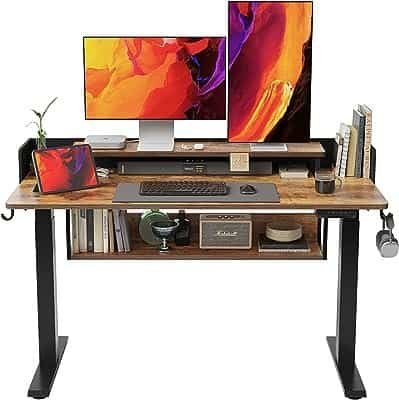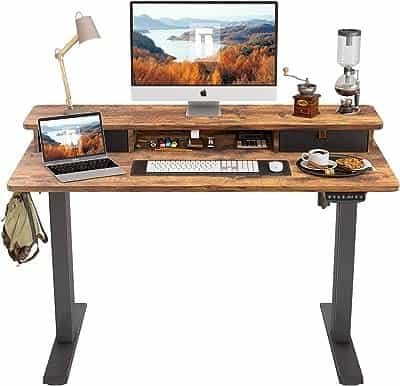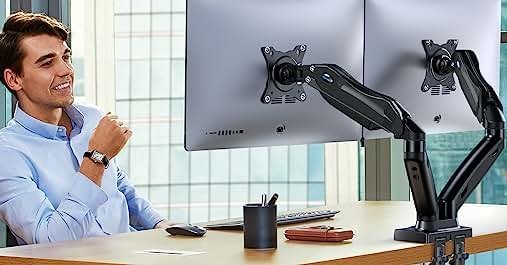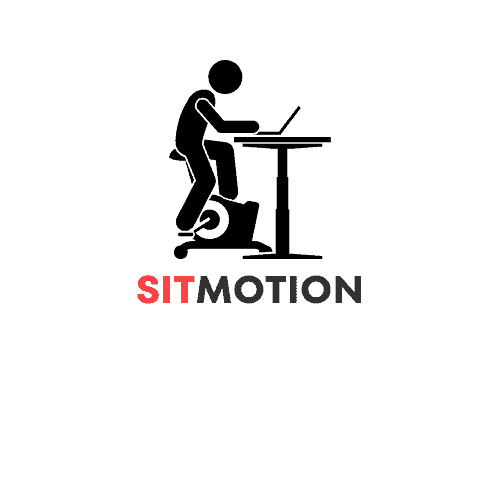Did you know that sitting for extended periods of time can have negative effects on your health? That’s why standing desks are becoming more popular in workplaces and home offices as an alternative to sitting desks. Not only do standing desks help reduce the risk of weight gain and obesity by burning calories, but they also have other health benefits such as lowering blood sugar levels, improving circulation, and reducing neck and back pain. In addition, using a standing desk correctly, by finding a balance between sitting and standing throughout the day, can boost your mood, increase your energy, and raise your productivity. So why not incorporate short periods of standing into your routine and gradually increase standing time to maximize the health benefits of a standing desk?

This image is property of Amazon.com.
Health Risks of Prolonged Sitting
Increased Risk of Chronic Diseases
Sitting for extended periods of time can pose serious health risks, greatly increasing the risk of developing chronic diseases. Research has shown a strong association between prolonged sitting and conditions such as diabetes, cardiovascular disease, and certain types of cancer. When you sit for long periods, your metabolism slows down, leading to decreased insulin sensitivity and impaired glucose metabolism. This can ultimately contribute to the development of chronic diseases.
Negative Effects on Metabolic Health and Weight Gain
Additionally, prolonged sitting can have negative effects on your metabolic health and contribute to weight gain. Sitting for extended periods leads to a decrease in the number of calories burned, as compared to standing or engaging in physical activity. This decrease in calorie expenditure can lead to weight gain and an increased risk of obesity. Furthermore, sitting for long periods of time can negatively impact your body’s ability to regulate blood sugar levels, which can further contribute to weight gain and the development of metabolic disorders.
Introduction to Standing Desks
Definition and Types of Standing Desks
Standing desks are becoming increasingly popular in workplaces and home offices as an alternative to traditional sitting desks. These desks are specifically designed to allow you to work in a standing position, promoting a more active and health-conscious lifestyle. There are different types of standing desks available, including manual adjustable desks, electric adjustable desks, and fixed-height standing desks. Manual adjustable desks require manual effort to raise or lower the desk height, while electric adjustable desks have motors that allow for easy adjustment with the push of a button. Fixed-height standing desks, as the name suggests, have a fixed height that cannot be adjusted.
Popularity of Standing Desks in Workplaces and Home Offices
The popularity of standing desks has surged in recent years, with more and more workplaces and home offices incorporating them into their environments. Many companies have recognized the health risks associated with prolonged sitting and have taken steps to provide their employees with standing desk options. This is driven by a growing understanding of the importance of maintaining an active lifestyle and the desire to create work environments that promote employee health and well-being. Similarly, individuals who work from home have also embraced standing desks as a way to improve their overall health and productivity.
Health Benefits of Standing Desks
Calorie Burning and Weight Management
One of the key health benefits of standing desks is the ability to burn more calories compared to sitting desks. Standing requires more energy expenditure than sitting, as it engages more muscles and increases your heart rate. Standing desks can help you burn additional calories throughout the day, contributing to weight management and potentially preventing weight gain. Incorporating periods of standing into your work routine can make a significant impact on your overall calorie expenditure.
Lowering Blood Sugar Levels and Reducing the Risk of Heart Disease
Standing after a meal can have beneficial effects on your blood sugar levels. Research has shown that standing for short periods after eating can significantly reduce the spike in blood sugar levels that typically occurs after a meal, particularly in individuals with diabetes or insulin resistance. This decrease in blood sugar levels can help reduce the risk of developing heart disease and other metabolic disorders associated with high blood sugar.
Improved Circulation and Reduced Neck and Back Pain
Standing desks promote better circulation throughout the body, as compared to sitting desks. When you stand, blood flows more freely and efficiently, helping to prevent blood clots and decreasing the risk of cardiovascular problems. Standing also helps reduce the strain on your neck and back, as it allows for a more natural alignment of the spine. This can help alleviate common issues such as neck pain, back pain, and stiffness, often experienced with prolonged sitting.
Enhanced Mood and Increased Energy
Using a standing desk can have a positive impact on your mood and energy levels. Standing promotes better blood flow to the brain, which can improve cognitive function and increase alertness. Additionally, standing releases endorphins, the feel-good hormones, which can help boost your mood and reduce stress levels. Many individuals who have transitioned to standing desks report feeling more energized and mentally refreshed throughout the day.
Raised Productivity
Standing desks have been found to have a positive effect on productivity. Research suggests that working in a standing position stimulates focus and concentration, leading to increased productivity levels. Standing also encourages more movement, preventing the stagnation and decrease in mental alertness that can occur with prolonged sitting. Additionally, the improved mood and increased energy levels associated with standing desks can enhance overall productivity and work performance.
Correct Usage of Standing Desks
Alternating Between Sitting and Standing
Using a standing desk correctly involves finding the right balance between sitting and standing throughout the day. It is important to avoid prolonged periods of either sitting or standing, as both can have negative effects on your health. Aim to alternate between sitting and standing every 30 minutes to one hour. This regular movement helps to distribute the load on your muscles and joints and prevents excessive strain or fatigue.
Finding the Right Balance for Maximum Health Benefits
Finding the right balance between sitting and standing is crucial for maximizing the health benefits of a standing desk. Start by incorporating short periods of standing into your daily routine and gradually increase the standing time as your body adjusts. Some individuals may find that standing for long periods causes discomfort or fatigue, while others may experience similar issues with prolonged sitting. It is important to pay attention to your body and find the balance that works best for you.
Gradually Increasing Standing Time
When using a standing desk, it is recommended to gradually increase your standing time over a period of time. Begin with short intervals of standing, such as 10-15 minutes, and gradually increase the duration as your body adapts. Consider using a timer or setting reminders to prompt you to switch between sitting and standing. It is essential to listen to your body and make adjustments as needed to ensure your comfort and avoid any negative effects of excessive standing.

This image is property of Amazon.com.
Ergonomics and Standing Desks
Proper Posture and Alignment
Maintaining proper posture and alignment is important when using a standing desk. Stand with your feet shoulder-width apart and your weight evenly distributed on both feet. Keep your knees slightly bent to reduce strain on your joints. Engage your core muscles to support your spine and avoid hunching or slouching. Your head should be in a neutral position, aligned with your spine, and your shoulders should be relaxed.
Adjusting Desk Height and Monitor Position
To ensure the optimal ergonomic setup, it is essential to adjust the height of your standing desk and the position of your computer monitor. The height of your desk should be set at a level that allows your arms to be bent at a 90-degree angle when typing, with your wrists in a neutral position. The top of your computer monitor should be at eye level, to prevent strain on your neck and minimize eye fatigue.
Footwear and Comfort Options
Choosing the right footwear is important when using a standing desk. Opt for supportive shoes that provide cushioning and shock absorption to minimize strain on your feet and joints. Consider wearing shoes with arch support or using orthotic inserts if needed. Additionally, incorporating anti-fatigue mats can provide additional cushioning and support, reducing discomfort and fatigue associated with prolonged standing. Using a footrest or foot stool can also help alleviate pressure on your feet and improve overall comfort.
Standing Desk Accessories
Anti-Fatigue Mats
Anti-fatigue matsare designed to provide cushioning and support for individuals who spend long periods of time standing. These mats help alleviate discomfort and fatigue by reducing the pressure on your feet and lower extremities. Anti-fatigue mats can be placed in front of your standing desk, providing a comfortable surface to stand on and reducing the impact on your joints.
Footrests and Foot Stools
Footrests and foot stools can be used in conjunction with standing desks to provide additional support and promote better posture. These accessories allow you to elevate one foot at a time, relieving pressure on your feet and reducing muscle fatigue. By alternating the footrest or foot stool, you can shift your weight and prevent the development of any standing-related discomfort.
Monitor Arms and Keyboard Trays
To optimize your ergonomic setup, consider using monitor arms and keyboard trays with your standing desk. Monitor arms allow you to adjust the height, angle, and position of your computer monitor, ensuring optimal viewing angles and reducing strain on your neck and eyes. Keyboard trays can be adjusted to a comfortable height and distance from your body, promoting proper wrist and arm alignment while typing.

This image is property of Amazon.com.
Considerations for Choosing a Standing Desk
Budget and Space Constraints
When choosing a standing desk, it is important to consider your budget and any space constraints you may have. Standing desks come in a variety of price ranges, so it is essential to determine your budget and explore options within that range. Additionally, consider the available space in your workplace or home office. Measure the area where you plan to place the desk to ensure it will fit comfortably and accommodate your work needs.
Electric vs. Manual Adjustable Desks
Another important consideration is whether to choose an electric adjustable desk or a manual adjustable desk. Electric adjustable desks offer the convenience of easy adjustments with the push of a button, allowing for seamless transitions between sitting and standing positions. Manual adjustable desks require more effort to raise or lower the desk, but they are often more budget-friendly. Consider your preferences and needs when deciding between the two options.
Design and Durability Factors
The design and durability of a standing desk are crucial considerations. Look for a desk that is sturdy, stable, and able to support the weight of your equipment. Pay attention to the quality of materials used and ensure that the desk is built to last. Additionally, consider the design aesthetics and how well the desk will fit into your workspace. Choosing a desk that is visually appealing and complements your existing decor can contribute to a positive and motivating work environment.
Additional Features and Accessories
Some standing desks come with additional features and accessories that can enhance your overall experience. These may include built-in cable management systems to keep your workspace organized, built-in USB ports for easy device charging, or even built-in whiteboards or corkboards for note-taking and organization. Assess your specific needs and preferences to determine which additional features and accessories would be beneficial for your work setup.
Standing Desk Alternatives
Treadmill Desks
Treadmill desks are a popular alternative to traditional standing desks, as they allow individuals to combine work with physical activity. With a treadmill desk, you have the option to walk or jog at a slow pace while working on your computer or performing other tasks. This provides the benefits of physical activity, such as increased calorie burn and improved cardiovascular health, while still allowing you to get work done. Treadmill desks are especially suitable for individuals with sedentary jobs who struggle to incorporate exercise into their daily routine.
Desk Converters and Riser Platforms
Desk converters and riser platforms are another alternative to standing desks. These devices can be placed on top of your existing traditional sitting desk and allow you to raise or lower your work surface as needed. Desk converters and riser platforms provide the flexibility to switch between sitting and standing positions without investing in a new desk. They are typically adjustable and can accommodate multiple monitors or other work equipment.
DIY Standing Desk Options
If budget constraints are a concern, there are many DIY standing desk options available. These include using stacked books or boxes to raise your laptop or computer monitor to a standing height, or using adjustable shelving units to create a makeshift standing desk. While these DIY options may not offer the same level of sturdiness or ergonomic features as commercial standing desks, they can provide a temporary solution or alternative for individuals with limited resources.
Research and Studies on Standing Desks
Scientific Evidence for the Health Benefits
Numerous scientific studies have been conducted on the health benefits of standing desks. Research consistently shows that using a standing desk can lead to increased calorie expenditure, improved blood sugar control, reduced risk of weight gain and obesity, and decreased musculoskeletal discomfort. These studies provide strong evidence supporting the positive impact of standing desks on overall health and well-being.
Long-term Effects on Health and Productivity
Long-term studies have also explored the effects of standing desks on health and productivity. These studies suggest that incorporating standing desks into the workplace can improve employee health, reduce the risk of chronic diseases, and positively impact work performance and productivity. Additionally, these studies indicate that individuals who use standing desks consistently over time experience sustained improvements in their overall health and well-being.
Comparison with Traditional Sitting Desks
Comparative studies between standing desks and traditional sitting desks have consistently shown the superiority of standing desks in terms of health benefits. Standing desks have been found to increase calorie burn, improve blood sugar levels, and reduce musculoskeletal discomfort, as compared to sitting desks. While traditional sitting desks may have their own advantages, such as stability and ease of use, the numerous health benefits associated with standing desks make them a more favorable choice.
User Feedback and Satisfaction
User feedback and satisfaction surveys also provide valuable insights into the benefits of standing desks. Many individuals who have incorporated standing desks into their work routines report positive changes in their health, energy levels, and overall well-being. Users often express increased satisfaction and productivity in their work, as well as a reduction in musculoskeletal discomfort and fatigue. These firsthand accounts further validate the effectiveness and impact of standing desks in improving daily work experiences.
Conclusion
In conclusion, the health risks associated with prolonged sitting have led to the rising popularity of standing desks in workplaces and home offices. Standing desks offer a multitude of health benefits, including increased calorie burn, improved blood sugar control, reduced risk of chronic diseases, and enhanced mental well-being. Correct usage of standing desks involves finding the right balance between sitting and standing, gradually increasing standing time, and maintaining proper posture and ergonomic alignment. Standing desk accessories and alternative options provide additional comfort and flexibility to cater to individual preferences and needs. The research and studies conducted on standing desks consistently demonstrate their effectiveness in improving health, productivity, and overall satisfaction. Consider investing in a standing desk to enhance your well-being and create a more dynamic and active work environment.



